The APA standards or references, as you may have noticed so far, have a specific structure for each type of appointment, reference, title, descriptive tables, images and even the way in which you present the general content of any text of a scientific or academic nature.
But since the best way to learn is by example, rather than a guide that tells you how to do it, I'm going to give you some concrete examples of the most common uses given to APA references in the presentation of written works. I will go in the logical order that they are presented, starting with the cover and ending with the bibliography or references, indexes of graphs and figures and annexes, so that you have a clear model to consult when you need to carry out any work.
General recommendations for the presentation of written works
You should know that when you present a written work and you want to do it under the APA standards or references there are some parameters that you must follow so that you fully comply with what the standard requires.
Although it is possible that the institution in which you are studying is a little more flexible in terms of some rules, it is good to know the generalities of the norm so that it is easier for you to adapt them later to what your institution requires. Thus, according to APA standards, all written work must:
- Submitted on letter size sheets (A4, 21cm x 27cm).
- All margins are equal, according to the new edition of the standard. The previous one contemplated a double margin on the left side due to the issue of binding, but the new edition left them all at 2.54cm, considering that currently the digital format is used more than the printed format.
- The recommended font type is Times New Roman in size 12.
- The line spacing or spacing throughout the text must be double (except for citations greater than 40 words that we will see later).
- All paragraphs must be indented 5 spaces on the first line (less in the references at the end where the spacing goes in the second line, but we will also see this later in detail).
- The text must always be aligned to the left (except for the cover that has the text centered).
In general terms, these are the recommendations for the texts that, according to the APA standards, must contain:
- Cover page that contains the title of the document, name of the author or authors, date, name of the institution, career and subject.
- Presentation page: similar to the cover but in this the city is added.
- Resumen (Abstract) in which a brief presentation of the entire document is made, it is recommended that it contain only between 600 and 900 characters.
- Content of the work: Under the specific rules for citations or references to be made, there is no limit to the number of pages or the number of chapters.
- References: are all the sources cited, it should not be confused with the bibliography in which all the sources consulted are included even if they have not been cited or referenced in the text.
- Footnotes page: all those that have been included in the work, there is no limit but it is recommended to use only those that are really necessary.
- Table index.
- Index of figures.
- Appendices or annexes.
How is a cover made according to APA standards?
The standards for making a cover, according to the sixth edition of the 2009 standard, which is still in force, indicate that the margins must be 2.54cm on the four sides of the page, the text must be centered and the Title, just because it is the cover, is all in capital letters (it is recommended that it does not contain more than 12 words).
Among the content that the cover should include is:
- Work title: all capitalized, centered on the top of the page.
- Author or authors: They go a little lower than the middle of the page and only the initials are placed in capital letters.
- Date: if there is no exact date, only the month and year of the document's publication should be entered. It is placed just below the name of the author or authors.
- Name of the Institution: It is placed like any proper name, with capital letters in each initial, and it goes at the bottom of the sheet, a few spaces below the date.
- Carrera: It applies to academic work, here is where the university degree is being studied or the degree in which it is, for example: engineering in systems mention in programming or II year of science mention in administration.
- Subject: This only applies in the case of academic work, the subject or subject for which the document is being prepared is placed.
Here is a cover of an academic text where you can see all these elements:
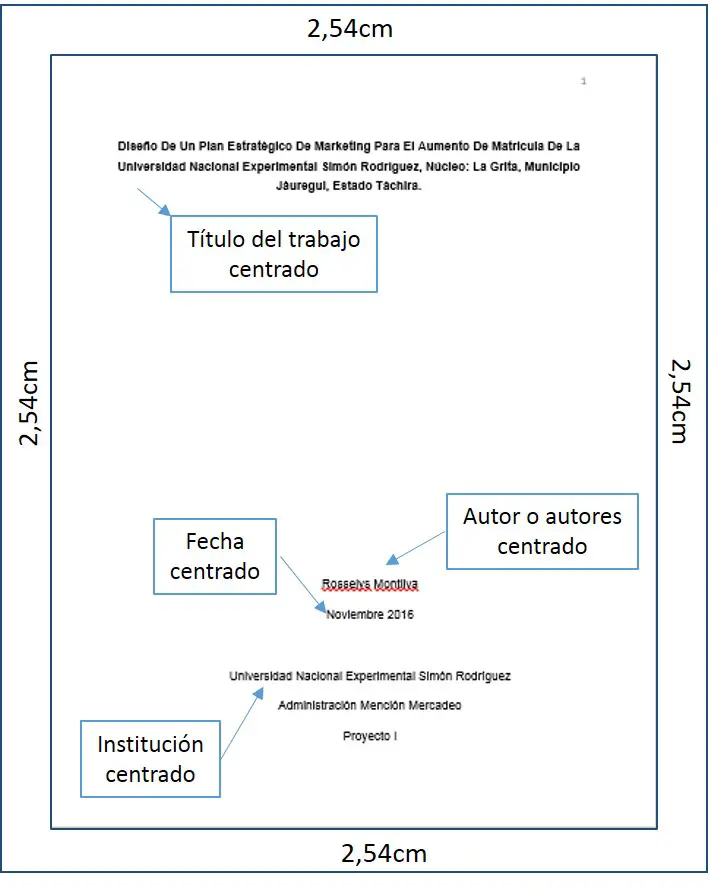
I will not make a different section for the presentation page because I just have to add that It is the same cover but at the end, under the subject, you put the city and the country in which the document is published.
Preparation of the Summary or Abstract according to APA standards
This part of the text is one of the things that is almost always left for last because, as its name implies, is a summary of the content of the entire publication. What is complicated to do it may be in the fact that it must summarize in only 900 characters (maximum) the content of hundreds of pages that can contain all the research work.
The specific rules for submission are as follows:
- It is not placed in the index: According to the APA standards, the page must be numbered, but the page is not placed in the index.
- It is recommended that you contain a short version of the title in the header that does not exceed 50 characters, this line must be all capital letters and above the word summary, aligned to the left.
- The word abstract (or Abstract) must be on the line immediately below the title abstract, centered and with the first letter in capital letters.
- The text should summarize the three main parts of the work: introductory section including the statement of the problem, central thesis or research carried out, conclusions or final dissertations.
- Indentation is not used in the first line of this text but if you are going to start a new paragraph if you must include it, although the ideal is that it be a single paragraph.
- All text must be in justified alignment, that is, square.
- There must be a line that contains the keywords of the text, in lowercase and separated by commas and with an indentation of five spaces at the beginning, the words must be contained in the text.
- There are those who prefer to include the English and Spanish versions of the abstract on the same page, however there is neither a restriction nor an obligation according to the norm regarding this.
Here is an example of how a summary prepared according to APA standards should look:
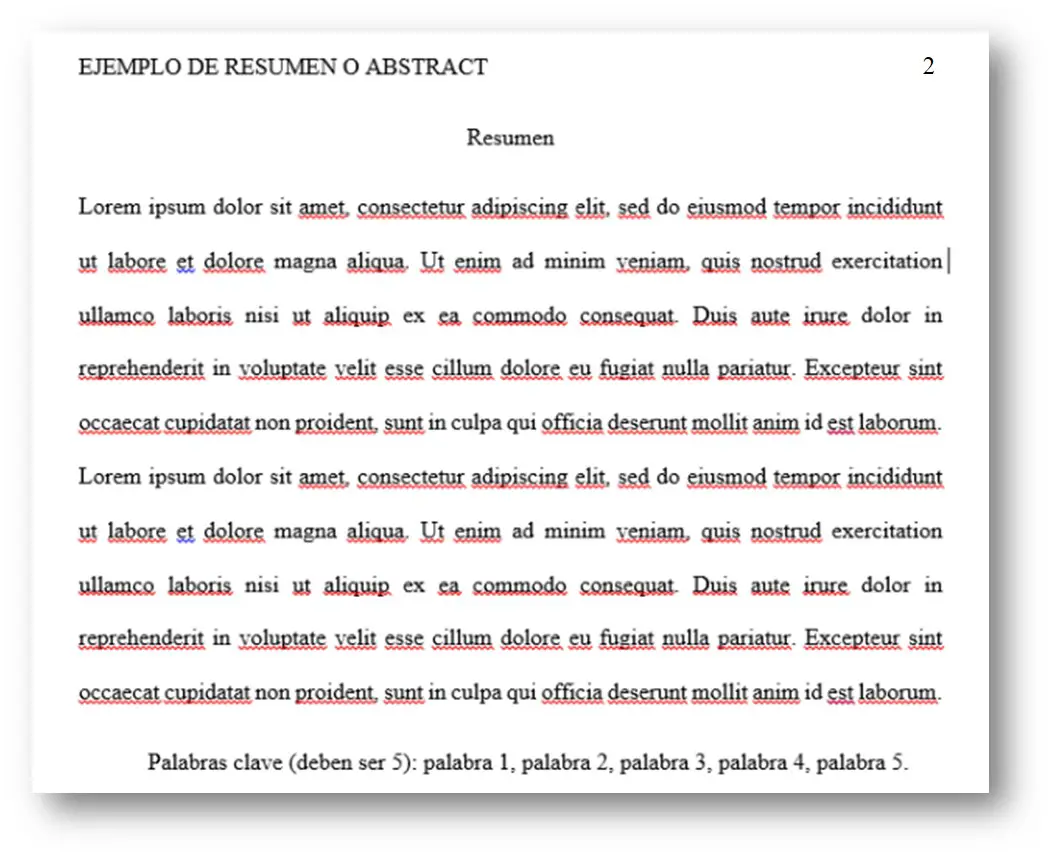
General rules for the content of the work
In the content of the work It is recommended to include citations or references of authors that support the research or the hypotheses that are being raised. Each of them has a different way of presenting themselves, already in the section on appointments I explained how they should be done, for which I invite you to see the examples on that page as a query and in this way we will move on to something that usually generates many doubts : the elaboration of the bibliography and the references.
References and bibliography: are they the same?
This is one of the main doubts that are generated when making that list of authors and books that is placed at the end of all research work and it is good to clarify the following: they are not the same well the reference list should contain only the books that have been cited in the text while the bibliography contains all the texts that have been consulted during the investigation, even if they have not been cited or referenced.
In this sense, the author must include both "lists" taking into account that the bibliography follows the referencesIn any case, both are presented in the same way and hence precisely the confusion, namely the presentation according to the norm indicates it is:
- They should be organized in alphabetical order, not in the order in which they appear in the text.
- The line spacing used is 1.5 and the alignment is indented (I'll explain how to do it in Word later).
- In the references there must be all the texts that were cited or referenced and in the bibliography all those that were consulted, you should not omit any, even if they are electronic sources.
Here is an example of how the references and bibliography should look:
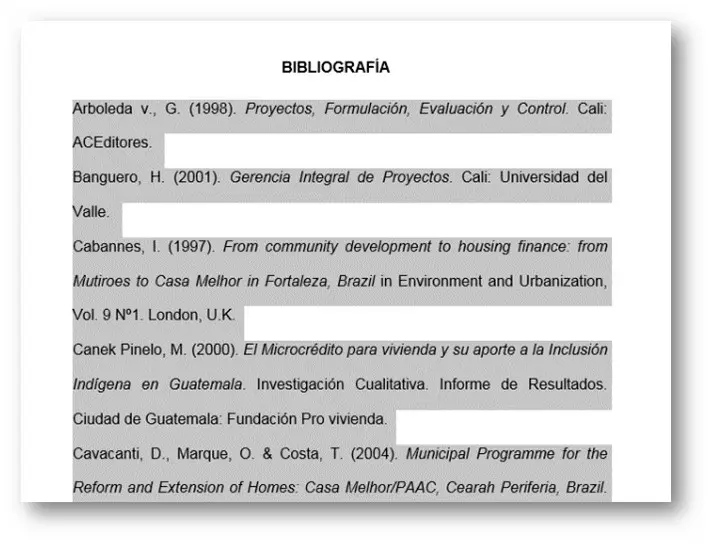
Making this indentation format in the bibliography is simpler than it sounds, once again Microsoft lets you do it automatically thanks to the Word tools. Here I explain step by step how to do it.
Step by step to add French indentation to bibliography
The first thing you should do is have all the text in the format required by APA: Author's last name, First initial. (Year of publication). Full title of the book. City: Editorial.
- Once you have your entire list of authors sorted alphabetically, without any bullets, like normal paragraphs, you select all the text you want to modify:
 2. At the top you find the tab Beginning and there you look at the bottom where it says "Paragraph”. You expand this section by clicking on the right corner that has a small arrow inside a box.
2. At the top you find the tab Beginning and there you look at the bottom where it says "Paragraph”. You expand this section by clicking on the right corner that has a small arrow inside a box.
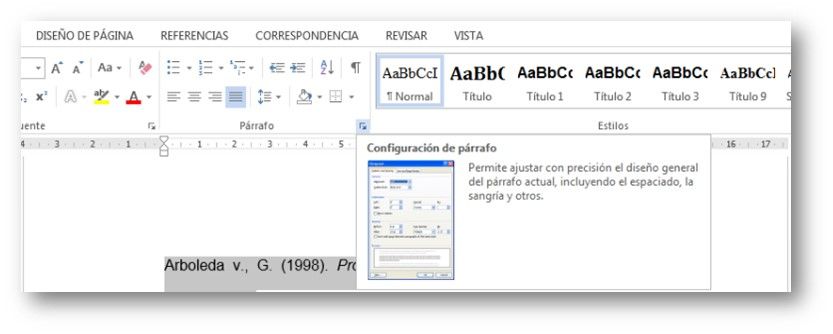 3. The dialog box will open. paragraph settings and inside it you should look for the second section called "Bleeding”. On the right side you will see a drop-down menu that indicates “Special sangria”. Select the option "French sangria"And press the"To accept”.
3. The dialog box will open. paragraph settings and inside it you should look for the second section called "Bleeding”. On the right side you will see a drop-down menu that indicates “Special sangria”. Select the option "French sangria"And press the"To accept”.
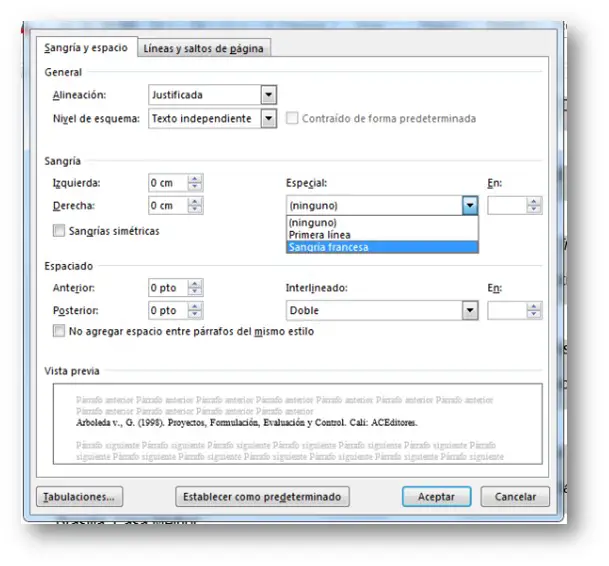 4. Your text will automatically take the format you need to give your references the APA style:
4. Your text will automatically take the format you need to give your references the APA style:
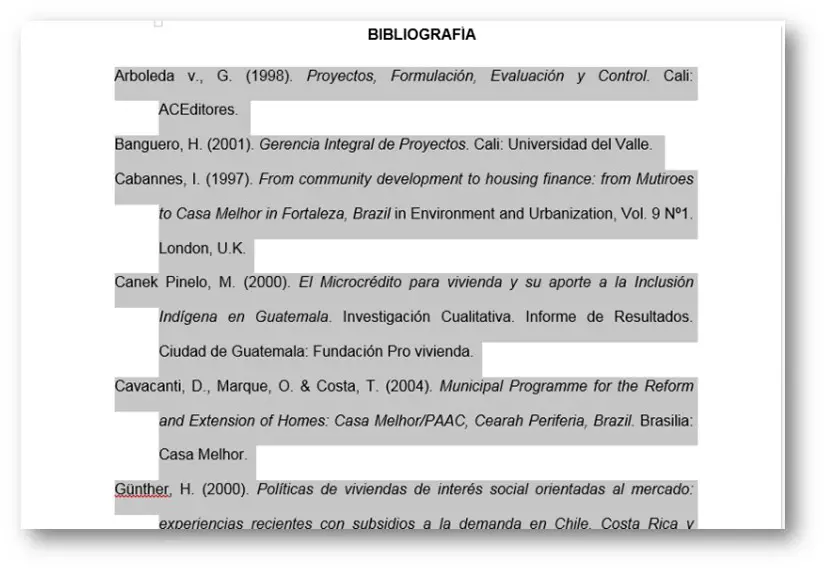
As you will see, it is a very simple procedure that will not take you more than 2 minutes to do it, but for it to work correctly and your references and bibliographies fit you well, I recommend you have all the information in the books arranged in the way I indicated that it should be done according to the APA style.
A good practice would be that to the extent that you are citing or consulting books, you will add them to your list of bibliographic sources in Word (I have already explained to you before how to add a new bibliographic source), that way in the end you will only have to add them to the bibliography.
The final parts of the written work
After you prepare the references and the bibliography (remember that it is the correct order in which they go) you will include the other parts that I mentioned at the beginning: footnotes, which are a little simpler in format since the double spacing is simply maintained as in the rest of the text and they are listed according to the order of appearance.
In the table index and the figure index (they are two different and you must also differentiate this in the content) you are going to place, according to their order of appearance in the content, all the tables and all the figures that you used.
The format in which it is presented remains the same: double-spaced and left-alignedRegarding the placement of guides (points) from the end of the text to the page number, the norm does not indicate anything specific, so it is something that is left to the discretion of the author or the institution.
Remember also that if you use the Word tool to list your tables and figures, at the end you can simply add the index automatically. There are many tutorials on the internet about the development of indexes, but I recommend that you consult the official Microsoft page where they explain the correct use of the tool.
Here's what the indexes should look like:
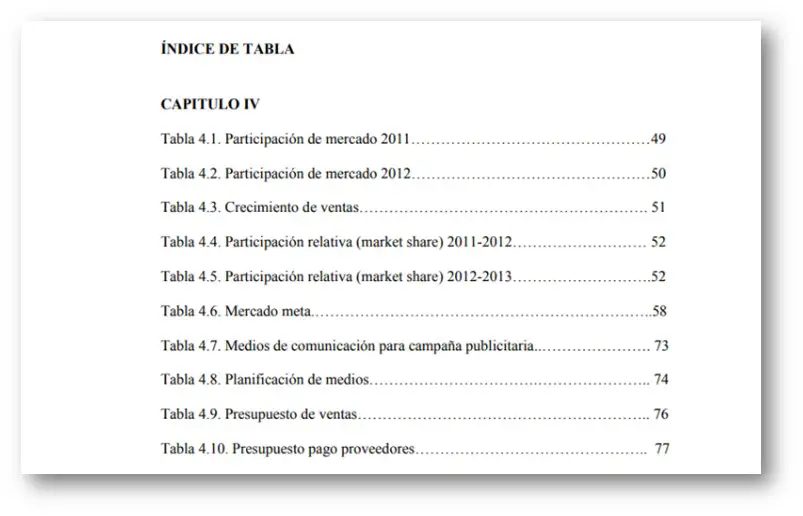
The annexes and appendices must be identified with a separate page that only contains the word annexes in the middle, all in capital letters and in this case it is allowed to use a larger font size to make it look good. Remember that these pages are part of the content so they must also be listed.
Graphics must be identified, numbered and the source must be cited from which they were obtained. Here is an example of how the attachments should look:
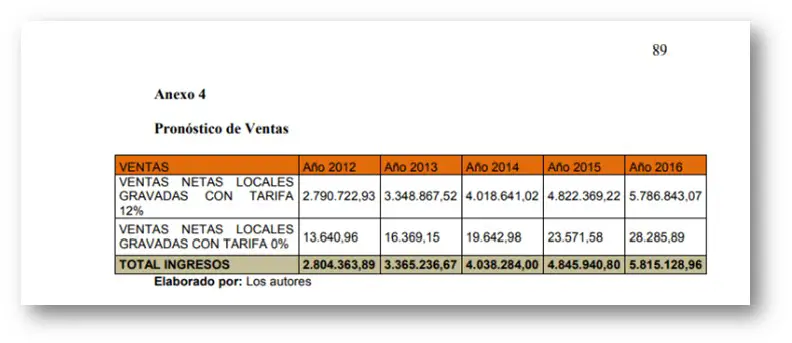
This is an overview of the main things you should know about APA references, remember that if you want more information about the standard or get the official manual you can go to the website of the American Association of Psychologists where it is published or to the official website of APA standards: www.apastyle.org.

